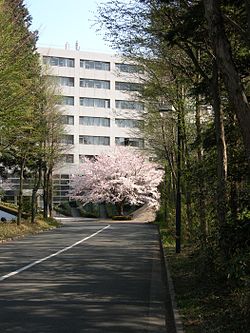Institute of Space and Astronautical Science

Entrance to the ISAS Sagamihara campus
Institute of Space and Astronautical Science (Japanese: 宇宙科学研究所, Hepburn: Uchū kagaku kenkyūjo) or ISAS,[1] is a Japanese national research organization. ISAS studies astrophysics using rockets and satellites. ISAS is part of the Japan Aerospace Exploration Agency (JAXA).[2]
History
The ISAS began at the University of Tokyo in the 1955.[3]
In 1994, Japan launched its first large rocket built solely with its own technology. According to Shigebumi Saito, former head of Japan's Space Activities Commission, "If we have no vehicle, it is like a navy without ships," [4]
ISAS was merged with two other space agencies in 2003 when JAXA was established.[5]
List of Satellites by ISAS
Before establishment of JAXA
| Launch date | Name before launch | Name after launch | Mission |
|---|---|---|---|
| February 11, 1970 | Ōsumi[6] | Technology demonstration | |
| February 16, 1971 | MS-T1 | Tansei[6] | Technology demonstration |
| September 28, 1971 | MS-F2 | Shinsei[6] | Ionosphere / cosmic-ray / solar-radio observation |
| August 19, 1972 | REXS | Denpa | Ionosphere / magnetosphere observation |
| February 16, 1974 | MS-T2 | Tansei 2 | Technology experiment |
| February 24, 1975 | SRATS | Taiyo | Thermosphere and sun |
| February 19, 1977 | MS-T3 | Tansei 3 | Technology experiment |
| February 4, 1978 | EXOS-A | Kyokko | Aurora and ionosphere |
| September 16, 1978 | EXOS-B | Jikiken | Magnetosphere and thermosphere observation |
| February 21, 1979 | CORSA-b | Hakucho | X-ray astronomy |
| February 17, 1980 | MS-T4 | Tansei 4 | Technology experiment |
| February 21, 1981 | ASTRO-A | Hinotori | Solar X-ray observation |
| February 20, 1983 | ASTRO-B | Tenma | X-ray astronomy |
| February 14, 1984 | EXOS-C | Ohzora | Mesosphere observation |
| January 8, 1985 | MS-T5 | Sakigake | Technology experiment / Comet observation |
| August 19, 1985 | PLANET-A | Suisei | Comet observation |
| August 19, 1987 | ASTRO-C | Ginga | X-ray astronomy |
| February 22, 1989 | EXOS-D | Akebono | Aurora observation |
| January 24, 1990 | MUSES-A | Hiten | Interplanetary technology experiment |
| August 30, 1991 | SOLAR-A | Yohkoh | Solar X-ray observation (with NASA / UK) |
| July 24, 1992 | GEOTAIL | GEOTAIL | Magnetosphere observation (with NASA) |
| February 20, 1993 | ASTRO-D[7] | ASCA | X-ray astronomy (with NASA) |
| March 18, 1995 | SFU | SFU | Multi-purpose experiment flyer (with NASDA / NEDO / USEF) |
| February 12, 1997 | MUSES-B | HALCA | Space VLBI technology development |
| July 4, 1998 | PLANET-B | Nozomi | Mars atmosphere observation |
| May 9, 2003 | MUSES-C | Hayabusa | Planetary sample return technology development |
After establishment of JAXA
| Launch date | Name before launch | Name after launch | Mission |
|---|---|---|---|
| July 10, 2005 | ASTRO-EII | Suzaku | X-ray astronomy |
| February 21, 2006 | ASTRO-F | Akari | Infrared astronomy |
| September 22, 2006 | SOLAR-B | Hinode[8] | Solar observation |
| September 13, 2007 | SELENE | Kaguya[9] | Lunar probe |
| May 20, 2010 | PLANET-C | Akatsuki | Venus atmosphere observation |
Related pages
References
- ↑ ISAS is an acronym. ISAS stands for "Institute of Space and Astronautical Science".
- ↑ Japan Aerospace Exploration Agency (JAXA), "About ISAS"; retrieved 2012-4-2.
- ↑ JAXA, "History of ISAS" Archived 2012-05-10 at the Wayback Machine; retrieved 2012-4-2.
- ↑ Pollack, Andrew. "First Big Space Rocket Is Launched by Japanese," New York Times. February 4, 1994; retrieved 2012-4-16.
- ↑ The English name Institute of Space and Astronautical Science is still used. For a short time, the Japanese name was changed to 宇宙科学研究本部, (literally, Space Science Research Division). In 2010, the name was changed back to the previous Uchū kagaku kenkyūjo (宇宙科学研究所).
- ↑ 6.0 6.1 6.2 Nussbaum, Louis-Frédéric. (2005). "Ōsumi" in Japan Encyclopedia, p. 762.
- ↑ Pollack, Andrew. "Japan's Satellite to Peer at Far Corner of Universe," New York Times. February 21, 1993; retrieved 2012-4-16.
- ↑ Yoshida, Norimasa et al. "Systemic Approach to Achieve Fine Pointing Requirement of Solar-B," in Automatic Control in Aerospace 2004 (ed., Alexander Nebylov), p. 101; excerpt, "The satellite is under development by the Institute of Space and Astronautical Science of the Japan Aerospace Exploration Agency (ISAS/JAXA) and the National Astronomical Observatory of Japan (NAOJ)."
- ↑ MCurry, Justin. "Japan launches biggest moon mission since Apollo landings," Guardian (UK). September 15, 2007; retrieved 2012-4-17.
Other websites
| Wikimedia Commons has media related to Lua error in Module:Commons_link at line 62: attempt to index field 'wikibase' (a nil value).. |
| Wikimedia Commons has media related to Lua error in Module:Commons_link at line 62: attempt to index field 'wikibase' (a nil value).. |
- Japan Aerospace Exploration Agency, ISAS site map Archived 2012-05-10 at the Wayback Machine